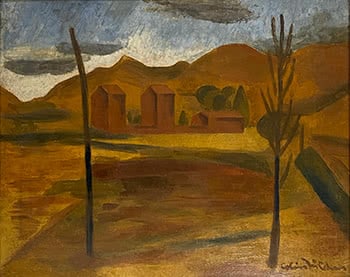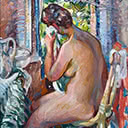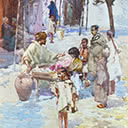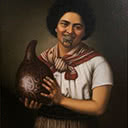Nelson Landscape, Tobacco Kilns, c. 1940
44.1 x 54.7 cm
est. $50,000 - 75,000
PROVENANCE Private Collection, Otago Recently released from long term loan at Christchurch Art Gallery, Te Puna o Waiwhetu
Colin McCahon database record number cm001049
EXHIBITED The Group: Exhibition of Drawings, Paintings, Etc Durham Street Art Gallery, Christchurch, 20/9/1940 - 26/9/1940
As early as 1938, the 19-year-old Dunedin painter Colin McCahon was exciting "considerable comment and discussion" in Wellington for his "very modern paintings", as the reviewer for the Wellington Sketch Club exhibition pointed out. Just the previous year, the Dunedin School of Art had moved into a new building, and it was now headed by Gordon Tovey (1901-1974), a renowned educationalist and modernist. McCahon had left Otago Boys' High School at mid-year and enrolled for tuition in painting from the English artist R N Field (1899-1987). Rejecting historical and conservative values such as the realistic depiction of subjects, McCahon was encouraged to restrict his palette to just a few colours and to innovate and experiment with form. The shapes, colours and lines which make up this early work - particularly the two silhouetted black trees which frame the buildings in the background like rugby posts - are reminiscent of the British surrealist painter and war artist Paul Nash (1889-1946). Nash's optimistically titled We Are Making A New World (1918), now in the Imperial War Museum, also depicts angular red buildings viewed through the trunks of bare trees, with a blue sky and scudding clouds above.
For Nash, depicting the scarred fields of Ypres, the message conveyed is that from death springs rebirth. With his tobacco fields landscape, McCahon, a pacifist who would unsuccessfully appeal for exemption from active service during the Second World War on conscientious grounds, is also creating a wartime painting which alludes to the futility of war. Working in the sunny Nelson region in the early years of the war provided respite from the harsh Dunedin winters, but McCahon also recognised that rural New Zealand was a kind of paradise, remote from European theatres of battle. The two trees in the foreground, one with branches and one without, have a symbolic quality, anticipating the crucifixion imagery which would appear in his work in the next decade.
Two months after Germany invaded Poland in September 1939, McCahon arrived in Nelson on the steamer Matangi, accompanied by his friend, the sculptor Fred Jones. They immediately found work picking tobacco on Herbert Helm's farm near Pangattara. Seasonal employment as a horticultural labourer was acceptable to pacifists as it was classified as "non-essential" to the war effort. McCahon wrote to his parents, "Pangatotara is a very beautiful place. Rather like West Coast scenery but not depressing."
Christchurch writer Courtney Archer and artists Rita Angus and Chrystabel Aitken followed to work there the following year, and in 1943 Doris Lusk painted her majestic Tobacco Fields, Pangatotara, Nelson (Auckland Art Gallery) dominated by the peak of The Crusader in the background.
Work in the tobacco fields was easy to find as the local industry had flourished during the 1930s. During the war, the number of cigarettes made in New Zealand increased exponentially, taking over the market from overseas suppliers, but there were fewer people available to harvest the tobacco. Just like Christopher Perkins' dairy factory, Rita Angus's Cass railway station and Doris Lusk's City Gas Works, McCahon's depiction of tobacco-curing barns in the landscape, known as oasts, can be seen as a celebration of regional development and industry in the New Zealand hinterland.
The day that this painting went on display in The Group's Spring 1940 exhibition alongside works by Evelyn Page, Louise Henderson, Ngaio Marsh, Rata Lovell-Smith, Olivia Spencer Bower, Margaret Anderson, Leo Bensemann and W H Allen, McCahon placed an advertisement in the Nelson Evening Mail: "Two young men with previous experience urgently require work tobacco planting or on orchard, willing to start immediately. Write Colin McCahon c/o GPO, Dunedin."
Ten days later he again disembarked from the steamer in Nelson, his art materials under his arm, this time heading to the Drummond's tobacco farm in the Riwaka Valley, a visit which occasioned another series of landscapes. Throughout the early 1940s, he would continue to return to the Nelson region, settling in Mapua with his wife and son in 1943, and beginning to explore figurative imagery and Christian themes.
LINDA TYLER





